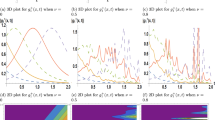Appendix
This section is devoted to prove a variance identity and a global Strichartz type estimate.
1.1 Proof of Proposition 2.12
Let u ∈ C([0,T],H1) be a local solution to Eq. ??. Testing the Eq. ?? by \(2\bar u\), one gets
$$ -2\Im(\bar u {\Delta} u)=\partial_{t} (|u|^{2}).$$
Thus,
$$V^{\prime}_{a}=-2{\int}_{\mathbb{R}^{N}}a\Im(\bar u{\Delta} u) dx=2\Im{\int}_{\mathbb{R}^{N}}(\partial_{k}a\partial_{k}u)\bar u dx=M_{a}.$$
Compute,
$$ \begin{array}{@{}rcl@{}} \partial_{t}\Im(\partial_{k} u\bar u) &=&\Im(\partial_{k}\dot u\bar u)+\Im(\partial_{k} u\bar{\dot u})\\ &=&\Re(i\dot u\partial_{k}\bar u)-\Re(i\partial_{k} \dot u\bar{u})\\ &=&\Re(\partial_{k}\bar u(-{\Delta} u-\mathcal N))-\Re(\bar u\partial_{k}(-{\Delta} u-\mathcal N))\\ &=&\Re(\bar u\partial_{k}{\Delta} u-\partial_{k}\bar u{\Delta} u)+\Re(\bar u\partial_{k}\mathcal N-\partial_{k}\bar u\mathcal N). \end{array} $$
Thanks to the equality,
$$\frac{1}{2}\partial_{k}{\Delta}(|u|^{2})=2\partial_{l}\Re(\partial_{k}u\partial_{l}\bar u)+\Re(\bar u\partial_{k}{\Delta} u-\partial_{k}\bar u{\Delta} u),$$
one has
$$ \begin{array}{@{}rcl@{}} {\int}_{\mathbb{R}^{N}}\partial_{k}a\Re(\bar u\partial_{k}{\Delta} u-\partial_{k}\bar u{\Delta} u) dx &=&{\int}_{\mathbb{R}^{N}}\partial_{k}a\Big(\frac{1}{2}\partial_{k}{\Delta}(|u|^{2})-2\partial_{l}\Re(\partial_{k}u\partial_{l}\bar u)\Big) dx\\ &=&2{\int}_{\mathbb{R}^{N}}\partial_{l}\partial_{k}a\Re(\partial_{k}u\partial_{l}\bar u) dx-\frac{1}{2}{\int}_{\mathbb{R}^{N}}{\Delta}^{2}a|u|^{2} dx. \end{array} $$
Moreover,
$$ \begin{array}{@{}rcl@{}} \Re(\bar u\partial_{k}\mathcal N) &=&\Re\Big(\bar u\partial_{k}[|x|^{b}|u|^{p-2}(I_{\alpha}*|\cdot|^{b}|u|^{p})u]\Big)\\ &=&\Re\Big(\bar u[(\alpha-N)|x|^{b}|u|^{p-2}(\frac{x_{k}}{|\cdot|^{2}}I_{\alpha}*|\cdot|^{b}|u|^{p})u]+[|x|^{b}|u|^{p-2}(I_{\alpha}*|\cdot|^{b}|u|^{p})\partial_{k}u]\Big)\\ &+&\Re\Big(\bar u(I_{\alpha}*|\cdot|^{b}|u|^{p})[bx_{k}|x|^{b-2}|u|^{p-2}u]+(p-2)[(I_{\alpha}*|\cdot|^{b}|u|^{p})|x|^{b}\Re(\partial_{k}u\bar u)|u|^{p-4}u]\Big)\\ &=&(\alpha-N)|x|^{b}|u|^{p}(\frac{x_{k}}{|\cdot|^{2}}I_{\alpha}*|\cdot|^{b}|u|^{p})+|x|^{b}|u|^{p-2}(I_{\alpha}*|\cdot|^{b}|u|^{p})\Re(\partial_{k}\bar u u)\\ &+&bx_{k}|x|^{b-2}|u|^{p}(I_{\alpha}*|\cdot|^{b}|u|^{p})+(p-2)|x|^{b}|u|^{p-2}(I_{\alpha}*|\cdot|^{b}|u|^{p})\Re(\partial_{k}u\bar u). \end{array} $$
Thus,
$$ \begin{array}{@{}rcl@{}} (A) &:=&{\int}_{\mathbb{R}^{N}}\partial_{k}a\Re(\bar u\partial_{k}\mathcal N-\partial_{k}\bar u\mathcal N) dx\\ &=&b{\int}_{\mathbb{R}^{N}}\partial_{k}ax_{k}|x|^{b-2}|u|^{p}(I_{\alpha}*|\cdot|^{b}|u|^{p}) dx+\frac{p-2}{2}{\int}_{\mathbb{R}^{N}}\partial_{k}a|x|^{b}(I_{\alpha}*|\cdot|^{b}|u|^{p})|u|^{p-2}\partial_{k}(|u|^{2}) dx\\ &&+(\alpha-N){\int}_{\mathbb{R}^{N}}\partial_{k}a|x|^{b}|u|^{p}\left( \frac{x_{k}}{|\cdot|^{2}}I_{\alpha}*|\cdot|^{b}|u|^{p}\right) dx\\ &=&b{\int}_{\mathbb{R}^{N}}\partial_{k}ax_{k}|x|^{b-2}|u|^{p}(I_{\alpha}*|\cdot|^{b}|u|^{p}) dx+\frac{p-2}p{\int}_{\mathbb{R}^{N}}\partial_{k}a|x|^{b}(I_{\alpha}*|\cdot|^{b}|u|^{p})\partial_{k}(|u|^{p}) dx\\ &&+(\alpha-N){\int}_{\mathbb{R}^{N}}\partial_{k}a|x|^{b}|u|^{p}\left( \frac{x_{k}}{|\cdot|^{2}}I_{\alpha}*|\cdot|^{b}|u|^{p}\right) dx. \end{array} $$
Write
$$ \begin{array}{@{}rcl@{}} (B) &:=&{\int}_{\mathbb{R}^{N}}\partial_{k}a|x|^{b}(I_{\alpha}*|\cdot|^{b}|u|^{p})\partial_{k}(|u|^{p}) dx\\ &=&-{\int}_{\mathbb{R}^{N}}{\Delta} a|x|^{b}|u|^{p}(I_{\alpha}*|\cdot|^{b}|u|^{p}) dx-(\alpha-N){\int}_{\mathbb{R}^{N}}\partial_{k} a\left( \frac{x_{k}}{|\cdot|^{2}}I_{\alpha}*|\cdot|^{b}|u|^{p}\right)|x|^{b}|u|^{p} dx\\ &-&b{\int}_{\mathbb{R}^{N}}\partial_{k}a(I_{\alpha}*|\cdot|^{b}|u|^{p})x_{k}|x|^{b-2}|u|^{p} dx. \end{array} $$
So,
$$ \begin{array}{@{}rcl@{}} (A) &=&(\alpha-N){\int}_{\mathbb{R}^{N}}\partial_{k}a(\frac{x_{k}}{|\cdot|^{2}}I_{\alpha}*|\cdot|^{b}|u|^{p})|x|^{b}|u|^{p} dx+b{\int}_{\mathbb{R}^{N}}\partial_{k}ax_{k}|x|^{b-2}|u|^{p}(I_{\alpha}*|\cdot|^{b}|u|^{p}) dx\\ &+&\frac{p-2}p(B)\\ &=&(\alpha-N){\int}_{\mathbb{R}^{N}}\partial_{k}a|x|^{b}|u|^{p}\left( \frac{x_{k}}{|\cdot|^{2}}I_{\alpha}*|\cdot|^{b}|u|^{p}\right) dx+b{\int}_{\mathbb{R}^{N}}\partial_{k}ax_{k}|x|^{b-2}|u|^{p}(I_{\alpha}*|\cdot|^{b}|u|^{p}) dx\\ &-&\frac{p-2}p\Big({\int}_{\mathbb{R}^{N}}{\Delta} a|x|^{b}|u|^{p}(I_{\alpha}*|\cdot|^{b}|u|^{p}) dx+(\alpha-N){\int}_{\mathbb{R}^{N}}\partial_{k} a|x|^{b}|u|^{p}\left( \frac{x_{k}}{|\cdot|^{2}}I_{\alpha}*|\cdot|^{b}|u|^{p}\right) dx\\ &+&b{\int}_{\mathbb{R}^{N}}\partial_{k}ax_{k}|x|^{b-2}|u|^{p}(I_{\alpha}*|\cdot|^{b}|u|^{p}) dx\Big)\\ &=&\frac{2}p\Big((\alpha - N){\int}_{\mathbb{R}^{N}}\partial_{k}a|x|^{b}|u|^{p}\left( \frac{x_{k}}{|\cdot|^{2}}I_{\alpha}*|\cdot|^{b}|u|^{p}\right) dx + b{\int}_{\mathbb{R}^{N}}\partial_{k}ax_{k}|x|^{b-2}|u|^{p}(I_{\alpha}*|\cdot|^{b}|u|^{p}) dx\Big)\\ &-&\frac{p-2}p{\int}_{\mathbb{R}^{N}}{\Delta} a|x|^{b}|u|^{p}(I_{\alpha}*|\cdot|^{b}|u|^{p}) dx. \end{array} $$
Finally,
$$ \begin{array}{@{}rcl@{}} V^{\prime\prime}_{a} &=&4{\int}_{\mathbb{R}^{N}}\partial_{l}\partial_{k}a\Re(\partial_{k}u\partial_{l}\bar u) dx-{\int}_{\mathbb{R}^{N}}{\Delta}^{2}a|u|^{2} dx-\frac{2(p-2)}p{\int}_{\mathbb{R}^{N}}{\Delta} a|x|^{b}|u|^{p}(I_{\alpha}*|\cdot|^{b}|u|^{p}) dx\\ &&+\frac{4}p\left( (\alpha-N){\int}_{\mathbb{R}^{N}}\partial_{k}a(\frac{x_{k}}{|\cdot|^{2}}I_{\alpha}*|\cdot|^{b}|u|^{p})|x|^{b}|u|^{p} dx\right.\\&&+b{\int}_{\mathbb{R}^{N}}\partial_{k}ax_{k}(I_{\alpha}*|\cdot|^{b}|u|^{p})|x|^{b-2}|u|^{p} dx\Big). \end{array} $$
This completes the proof.
1.2 Proof of Lemma 4.2
Denote, for \(D\subset \mathbb {R}^{N}\), \(S_{T}(D):=\cap _{(q,r)\in {\Gamma }}{L^{q}_{T}}(L^{r}(D))\). With Duhamel formula and Strichartz estimates, one gets
$$ \begin{array}{@{}rcl@{}} (E) &:=&\|\left\langle -e^{i.{\Delta}}u_{0}+u\right\rangle\|_{S(0,T)}\\ &\lesssim&\||x|^{b}|u|^{p-1}[I_{\alpha}*|\cdot|^{b}|u|^{p}]\|_{S_{T}^{\prime}(|x|<1)}+\|\nabla\Big(|x|^{b}|u|^{p-2}[I_{\alpha}*|\cdot|^{b}|u|^{p}]u\Big)\|_{S_{T}^{\prime}(|x|<1)}\\ &+&\||x|^{b}|u|^{p-1}[I_{\alpha}*|\cdot|^{b}|u|^{p}]\|_{S_{T}^{\prime}(|x|>1)}+\|\nabla\Big(|x|^{b}|u|^{p-2}[I_{\alpha}*|\cdot|^{b}|u|^{p}]u\Big)\|_{S_{T}^{\prime}(|x|>1)}\\ \end{array} $$
Take \(\mu _{1}:=(\frac N{-b})^{-}\), \(r_{1}:=\frac {2Np}{\alpha +N-\frac {2N}{\mu _{1}}}\) and (q1,r1) ∈Γ. Then, \(1+\frac \alpha N=\frac 2{\mu _{1}}+\frac {2p}{r_{1}}\) and using Hölder and Hardy-Littlewood-Sobolev inequalities, one gets for 𝜃1 := q1 − 2,
$$ \begin{array}{@{}rcl@{}} (A_{1}) & := & \|\mathcal {N}_{1}\|s_{T}^{\prime}(|x|{<}1)\\ &\lesssim&\|(I_{\alpha}*|\cdot|^{b}|u|^{p})|x|^{b}|u|^{p-1}\|_{L^{q_{1}^{\prime}}_{T}(L^{r^{\prime}_{1}}(|x|<1))}\\\\ &\lesssim&\||x|^{b}\|_{L^{\mu}(|x|<1)}^{2}\|\|u\|_{r_{1}}^{2p-1}\|_{L^{q^{\prime}_{1}}(0,T)}\\ &\lesssim&\|u\|_{L^{\infty}_{T}(L^{r_{1}})}^{2(p-1)-\theta_{1}}\|u\|_{L^{q_{1}}_{T}(L^{r_{1}})}^{1+\theta_{1}}, \end{array} $$
The condition p > p∗ gives \((2p-1)q^{\prime }_{1}>q_{1}\) and
Moreover, p ∈ (p∗,p∗) implies that \(2<r_{1}<\frac {2N}{N-2}\). Now, compute
$$ \begin{array}{@{}rcl@{}} (F) &:=&|\nabla(|x|^{b}|u|^{p-2}(I_{\alpha} *|\cdot|^{b}|u|^{p})u)|\\ &\lesssim& ||x|^{b}|u|^{p-2}(I_{\alpha}*|\cdot|^{b}|u|^{p})\nabla u|+||x|^{b}|u|^{p-1}(I_{\alpha} *|\cdot|^{b}\Re(\nabla u\bar u)|u|^{p-2})|\\ &&+||x|^{b-1}|u|^{p-1}(I_{\alpha}*|\cdot|^{b}|u|^{p})|+||x|^{b}|u|^{p-1}(I_{\alpha}*|\cdot|^{b-1}|u|^{p})|. \end{array} $$
The first and second terms are controlled as previously.
$$ \begin{array}{@{}rcl@{}} (B_{1}) &\!:=\!&\||x|^{b}|u|^{p-2}(I_{\alpha}*|\cdot|^{b}|u|^{p})\nabla u\|_{S_{T}^{\prime}(|x|<1)} + \||x|^{b}|u|^{p-1}(I_{\alpha} *|\cdot|^{b}\Re(\nabla u\bar u)|u|^{p-2})\|_{S_{T}^{\prime}(|x|<1)}\\ &\!\lesssim\!&\|u\|_{L^{\infty}_{T}(L^{r_{1}})}^{2(p-1)-\theta_{1}}\|u\|_{L^{q_{1}}_{T}(W^{1,r_{1}})}^{1+\theta_{1}}. \end{array} $$
Choosing \(\rho :=(\frac N{1-2b})^{-}\) and \(r_{2}:=\frac {2Np}{1+N+\alpha -\frac N\rho }=\Big (\frac {2Np}{N+\alpha +2b}\Big )^{+}\), one has
$$1+\frac\alpha N=\frac{1}{r_{2}}+\frac1{\rho}+\frac{2(p-1)}{r_{2}}+\frac{1}{r_{2}}-\frac1N.$$
Since \(\frac 1\rho :=(\frac {1-b}N)^{+}+(\frac {-b}N)^{+}:=\frac 1{a_{1}}+\frac 1{a_{2}}\), by Lemma 2.13 and Hölder inequality, one gets
$$ \begin{array}{@{}rcl@{}} (B_{2}) &:=&\||x|^{b-1}|u|^{p-1}(I_{\alpha}*\chi_{|{\cdot}|<1}|\cdot|^{b}|u|^{p})\|_{L^{q_{2}^{\prime}}_{T}(L^{r_{2}^{\prime}}(|x|<1))}\\ &&+\||x|^{b}|u|^{p-1}(I_{\alpha}*\chi_{|{\cdot}|<1}|\cdot|^{b-1}|u|^{p})\|_{L^{q_{2}^{\prime}}_{T}(L^{r_{2}^{\prime}}(|x|<1))}\\ &\lesssim&\|\||x|^{b}\|_{L^{a_{1}}(|x|<1)}\||x|^{b-1}\|_{L^{a_{2}}(|x|<1)}\|u\|_{r_{2}}^{2(p-1)}\|u\|_{\frac{Nr_{2}}{N-r_{2}}}\|_{L^{q_{2}^{\prime}}(0,T)}\\ &\lesssim&\|u\|_{L^{\infty}_{T}(L^{r_{2}})}^{2(p-1)-\theta_{2}}\|u\|_{L^{q_{2}}_{T}(W^{1,r_{2}})}^{1+\theta_{2}}, \end{array} $$
where \((1+\theta _{2})q_{2}^{\prime }=q_{2}\) and (q2,r2) ∈Γ. The condition p ∈ (p∗,p∗) gives 2 < q2 < 2p which is equivalent to 0 < 𝜃2 < 2(p − 1).
The estimation of the terms in the complementary of the unit ball follow similarly. This finishes the proof.
1.3 Proof of Lemma 4.3
Let us start with proving the estimate
$$\|\mathcal N\|_{S^{\prime}(I)}\lesssim\|u\|_{L^{\infty}(I,H^{1})}^{\theta}\|u\|_{S^{s_{c}}(I)}^{2(p-1)-\theta}\|u\|_{S(I)}.$$
Take 0 < 𝜃 << 1 and the pairs
$$ \begin{array}{@{}rcl@{}} (q,r)&:=&\Big(\frac{4(p-1)(2p-\theta)}{2(p-1)B-\theta(B-2)},\frac{2N(p-1)(2p-\theta)}{2(p-1)(Np-B)+\theta(B-2-N(p-1))}\Big)\in{\Gamma};\\ (a,r)&:=&\Big(\frac{2(p-1)(2p-\theta)}{2p-B},r\Big)\in{\Gamma}_{s_{c}};\\ (d,r)&:=&\Big(\frac{2(p-1)(2p-\theta)}{2p(B-1)-B+-\theta(B-2)},r\Big)\in{\Gamma}_{-s_{c}}. \end{array} $$
Take two real numbers μ > 0 and \(r_{1}:=\frac {2N}{N-2}\) such that
$$1+\frac\alpha N=\frac2\mu+\frac{2p-\theta}r+\frac\theta{r_{1}}.$$
By Lemma 2.13 and Hölder estimate, one obtains
$$\|\mathcal{N}_{1}\|_{L^{r^{\prime}}(|x|<1)}\leq\||x|^{b}\|_{L^{\mu}(|x|<1)}^{2}\|u\|_{r_{1}}^{\theta}\|u\|_{r}^{2p-1-\theta}.$$
Then, p < p∗ gives
$$\frac{N}{\mu}+b=\frac{\theta}{2}\Big(\frac{2+b}{2(p-1)}-\frac{N}{r_{1}}\Big)=\frac{\theta}{4}\Big(\frac{2+\alpha+2b}{p-1}-N+2\Big)>0.$$
Thus, one gets
$$ \begin{array}{@{}rcl@{}} \|\mathcal{N}_{1}\|_{L^{r^{\prime}}(|x|<1)} &\lesssim&\|u\|_{r_{1}}^{\theta}\|u\|_{r}^{2p-1-\theta}\\ &\lesssim&\|u\|_{H^{1}}^{\theta}\|u\|_{r}^{2p-1-\theta}. \end{array} $$
So, taking account of the equality \(\frac 1{q^{\prime }}=\frac {2(p-1)-\theta }a+\frac 1q\), one gets
$$ \begin{array}{@{}rcl@{}} \|\mathcal{N}_{1}\|_{L^{q^{\prime}}(I,L^{r^{\prime}}(|x|<1))} &\lesssim&\|u\|_{L^{\infty}(I,H^{1})}^{\theta}\|u\|_{L^{a}(I,L^{r})}^{2p-2-\theta}\|u\|_{L^{q}(I,L^{r})}\\ &\lesssim&\|u\|_{L^{\infty}(I,H^{1})}^{\theta}\|u\|_{S^{s_{c}}(I)}^{2p-2-\theta}\|u\|_{S(I)}. \end{array} $$
The estimate on the complementary of the ball follows similarly. This proves the first point. Now, one estimates
$$ \begin{array}{@{}rcl@{}} \|\nabla\mathcal N\|_{S^{\prime}(I)} &\lesssim&\||x|^{b}|u|^{p-1}(I_{\alpha}*|\cdot|^{b}|u|^{p-1}\nabla u)\|_{S^{\prime}(I)}\\ &&+\||x|^{b}|u|^{p-1}(I_{\alpha}*|\cdot|^{b-1}|u|^{p})\|_{S^{\prime}(I)}\\ &&+\||x|^{b}|u|^{p-2}(I_{\alpha}*|\cdot|^{b}|u|^{p})\nabla u\|_{S^{\prime}(I)}\\ &&+\||x|^{b-1}|u|^{p-1}(I_{\alpha}*|\cdot|^{b}|u|^{p})\|_{S^{\prime}(I)}\\ &:=&(I)+(II)+(III)+(IV). \end{array} $$
Using the above calculus, one has
$$(I)+(III)\lesssim\|u\|_{L^{\infty}(I,H^{1})}^{\theta}\|u\|_{S^{s_{c}}(I)}^{2p-2-\theta}\|\nabla u\|_{S(I)}.$$
The rest of the proof discusses two cases. First, let us take N = 3 and estimate the term
$$ \begin{array}{@{}rcl@{}} (II_{1}) &\lesssim&\||x|^{b}|u|^{p-1}(I_{\alpha}*\chi_{|{\cdot}|<1}|\cdot|^{b-1}|u|^{p})\|_{L^{2}(I,L^{\frac{6}{5}}(|x|<1))}\\ &\lesssim&\|\||x|^{b-1}\|_{L^{\mu_{1}}(|x|<1)}\||x|^{b}\|_{L^{\mu_{2}}(|x|<1)}\|u\|_{r_{1}}^{\theta}\|u\|_{r_{2}}^{2(p-1)-\theta}\|u\|_{r_{3}}^{\gamma}\|u\|_{6}^{1-\gamma}\|_{L^{2}(I)}\\ &\lesssim&\|\||x|^{b-1}\|_{L^{\mu_{1}}(|x|<1)}\||x|^{b}\|_{L^{\mu_{2}}(|x|<1)}\|u\|_{r_{1}}^{\theta}\|\nabla u\|_{n}^{2(p-1)-\theta}\|\nabla u\|_{n}^{\gamma}\|u\|_{H^{1}}^{1-\gamma}\|_{L^{2}(I)}. \end{array} $$
Here,
$$ \begin{array}{@{}rcl@{}} \frac56+\frac\alpha3 &=&\frac1{\mu_{1}}+\frac1{\mu_{2}}+\frac\theta{r_{1}}+\frac{2p-2-\theta}{r_{2}}+\frac\gamma{r_{3}}+\frac{1-\gamma}{6}\\ &:=&\frac1{\mu}+\frac\theta{r_{1}}+(2p-2-\theta+\gamma)(\frac1n-\frac13)+\frac{1-\gamma}{6}. \end{array} $$
Choose
$$ \begin{array}{@{}rcl@{}} -2b&<&\gamma<1,\quad 0<\epsilon<2b+\gamma;\\ \theta&:=&\frac{(2-\epsilon+\gamma+4b)(p-1)}{2+2b};\\ \frac{6\theta}{r_{1}}&:=&\frac{(2+2b+\alpha)\theta}{p-1}+2p-4-\theta+\gamma-\epsilon;\\ \frac1n&:=&\frac13+\frac\epsilon{6(2p-2-\theta+\gamma)}. \end{array} $$
This gives 0 < 𝜃 < 2(p − 1). The conditions \(|x|^{b-1}\in L^{\mu _{1}}\) and \(|x|^{b}\in L^{\mu _{2}}\) are satisfied if \(\frac N{\mu }+2b-1>0\). Compute
$$ \begin{array}{@{}rcl@{}} \frac N{\mu}+2b-1 &=&\frac3{\mu}+2b-1\\ &=&2b-1+\alpha+\frac52-3\Big(\frac\theta{r_{1}}+(2p-2-\theta+\gamma)(\frac1n-\frac13)+\frac{1-\gamma}{6}\Big)\\ &=&2b+1+\alpha-\frac{3\theta}{r_{1}}-(2p-2-\theta+\gamma)(\frac3n-1)+\frac{\gamma}2. \end{array} $$
Thus,
$$ \begin{array}{@{}rcl@{}} \frac N{\mu}+2b-1 &=&2b+1+\alpha-\frac{1}{2}\Big(\frac{(2+2b+\alpha)\theta}{p-1}+2p-4-\theta+\gamma-\epsilon\Big)\\ &&-(2p-2-\theta+\gamma)\frac\epsilon{2(2p-2-\theta+\gamma)}+\frac{\gamma}2\\ &=&2b+1+\alpha-\frac{1}{2}\Big(\frac{(2+2b+\alpha)\theta}{p-1}+2p-4-\theta\Big)\\ &=&2b+2+\alpha-(p-1)+\frac\theta2-\frac{(2+2b+\alpha)\theta}{2(p-1)}\\ &=&2b+2+\alpha+2(p-1)-\theta-3(p-1)+\theta\Big(\frac{3}2-\frac{2+2b+\alpha}{2(p-1)}\Big)\\ &=&2(p-1)-\theta-2(p-1)\Big(\frac{3}{2}-\frac{2+2b+\alpha}{2(p-1)}\Big)+\theta\Big(\frac{3}2-\frac{2+2b+\alpha}{2(p-1)}\Big)\\ &=&(1-s_{c})\Big(2(p-1)-\theta\Big)>0. \end{array} $$
This gives
$$ \begin{array}{@{}rcl@{}} (II_{1}) &\lesssim&\|\|u\|_{r_{1}}^{\theta}\|\nabla u\|_{n}^{2(p-1)-\theta+\gamma}\|u\|_{H^{1}}^{1-\gamma}\|_{L^{2}(I)}. \end{array} $$
Now, let the real numbers
$$m:=\frac{4(2p-2-\theta+\gamma)}{2p-2-\theta+\gamma-\varepsilon}\quad\text{and}\quad q_{1}:=\frac{4\theta}{2+\epsilon-(2p-2-\theta+\gamma)}.$$
Thus,
$$ \begin{array}{@{}rcl@{}} (m,n)\in{\Gamma}, \quad (q_{1},r_{1})\in{\Gamma}_{s_{c}};\\ \frac{1}{2}=\frac{\theta}{q_{1}}+\frac{2p-2-\theta+\gamma}{m}. \end{array} $$
Thus, by Hölder estimate, one gets
$$ \begin{array}{@{}rcl@{}} (II_{1}) &\lesssim&\|\|u\|_{r_{1}}^{\theta}\|\nabla u\|_{n}^{2(p-1)-\theta+\gamma}\|u\|_{H^{1}}^{1-\gamma}\|_{L^{2}(I)}\\ &\lesssim&\|u\|_{L^{q_{1}}(I,L^{r_{1}})}^{\theta}\|\nabla u\|_{L^{m}(I,L^{n})}^{2(p-1)-\theta+\gamma}\|u\|_{L^{\infty}(I,H^{1})}^{1-\gamma}\\ &\lesssim&\|u\|_{L^{\infty}(I,H^{1})}^{1-\gamma}\|u\|_{S^{s_{c}}(I)}^{\theta}\|\nabla u\|_{S(I)}^{2(p-1)-\theta+\gamma}. \end{array} $$
The estimate on the complementary of the unit ball and the term (IV ) follow similarly. Let us treat the case N > 3 and estimate the term (II1). Take the admissible pairs
$$ \begin{array}{@{}rcl@{}} (q,r)&:=&\left( \frac{2(2p-\theta)}{s_{c}(2p-\theta)+2(1-s_{c})},\frac{2N(2p-\theta)}{(N-2s_{c})(2p-\theta)-4(1-s_{c})}\right)\in{\Gamma};\\ (a,r)&:=&\left( \frac{2p-\theta}{1-s_{c}},r\right)\in{\Gamma}_{s_{c}}. \end{array} $$
By Lemma 2.13 and Hölder estimate, one obtains
$$ \begin{array}{@{}rcl@{}} (II_{1}) &\lesssim&\||x|^{b}|u|^{p-1}(I_{\alpha}*\chi_{|{\cdot}|<1}|\cdot|^{b-1}|u|^{p})\|_{L^{q^{\prime}}(I,L^{r^{\prime}}(|x|<1))}\\ &\lesssim&\|\||x|^{b-1}\|_{L^{\mu_{1}}(|x|<1)}\||x|^{b}\|_{L^{\mu_{2}}(|x|<1)}\|u\|_{2^{*}}^{\theta}\|u\|_{r}^{2p-2-\theta}\|u\|_{\frac{Nr}{N-r}}\|_{L^{q^{\prime}}(I)}\\ &\lesssim&\|\||x|^{b-1}\|_{L^{\mu_{1}}(|x|<1)}\||x|^{b}\|_{L^{\mu_{2}}(|x|<1)}\|u\|_{2^{*}}^{\theta}\| u\|_{r}^{2p-2-\theta}\|\nabla u\|_{r}\|_{L^{q^{\prime}}(I)}. \end{array} $$
Here,
$$ \begin{array}{@{}rcl@{}} 1+\frac\alpha N &=&\frac1r+\frac1{\mu_{1}}+\frac1{\mu_{2}}+\frac\theta{2^{*}}+\frac{2p-2-\theta}{r}+\frac1r-\frac1N\\ &:=&\frac1{\mu}+\frac\theta{2^{*}}+\frac{2p-\theta}{r}-\frac1N. \end{array} $$
Compute
$$ \begin{array}{@{}rcl@{}} \frac N\mu+2b-1 &=&\alpha+N+2b-\theta(\frac N2-1)-\frac{N(2p-\theta)}{r}\\ &=&\alpha+N+2b-\theta(\frac N2-1)-\frac{(N-2s_{c})(2p-\theta)-4(1-s_{c})}2\\ &=&\alpha+N+2b-\theta(1-s_{c})-(p-1)(N-2s_{c})-(N-2s_{c})+2(1-s_{c})\\ &=&\alpha+N+2b-\theta(1-s_{c})-(2+\alpha+2b)+2-N\\ &=&\theta(1-s_{c})>0. \end{array} $$
This implies, via the equality \(\frac 1{q^{\prime }}=\frac 1q+\frac {2p-2-\theta }a\), that
$$ \begin{array}{@{}rcl@{}} (II_{1}) &\lesssim&\|\|u\|_{2^{*}}^{\theta}\| u\|_{r}^{2p-2-\theta}\|\nabla u\|_{r}\|_{L^{q^{\prime}}(I)}\\ &\lesssim&\|u\|_{L^{\infty}(I,H^{1})}^{\theta}\|u\|_{L^{a}(I,L^{r})}^{2p-2-\theta}\|\nabla u\|_{L^{q}(I,L^{r})}\\ &\lesssim&\|u\|_{L^{\infty}(I,H^{1})}^{\theta}\|u\|_{S^{s_{c}}(I)}^{2p-2-\theta}\|\nabla u\|_{S(I)}\\ \end{array} $$
This ends the proof.




